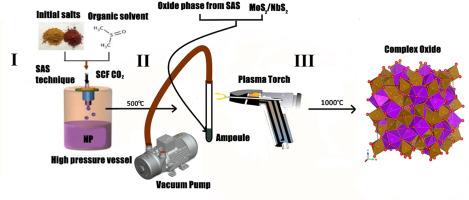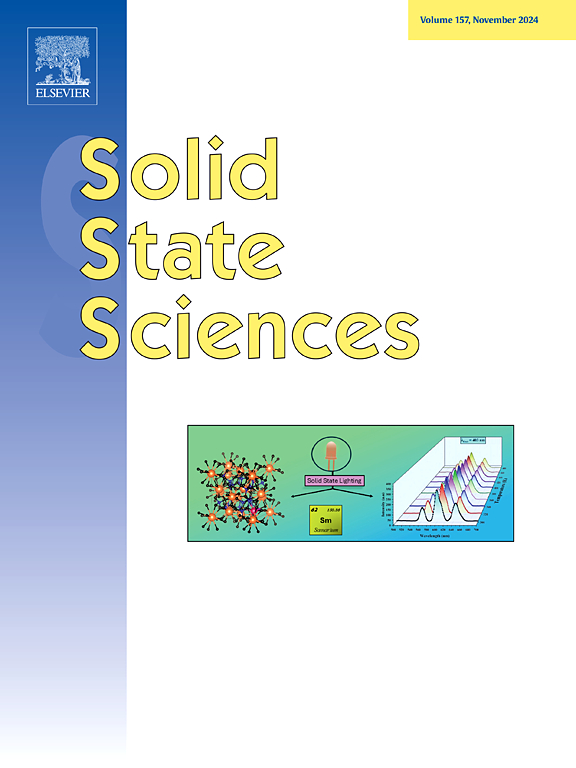利用超临界СО2流体合成具有石榴石结构的纳米相
IF 3.4
3区 化学
Q2 CHEMISTRY, INORGANIC & NUCLEAR
引用次数: 0
摘要
我们开发了一种生产纳米级复合氧化物和氧化硫的方法。第一阶段使用超临界 СО2 流体(SAS - 超临界反溶剂法)。这种方法可以在较窄的纳米尺度范围内获得不含前驱体的复合氧化物。我们获得了通式为 R3Fe5O12(其中 R 为稀土元素)的纳米级稀土铁榴石,并通过物理化学方法对其进行了研究。所得样品的尺寸小于 100 纳米,具有铁磁有序性,可用作软磁材料。这种多阶段制备复杂氧化硫的方法在以前的文献中从未出现过。该方法包括三个阶段。第一阶段,使用 SAS 方法获得原始盐类的纳米级 X 射线无定形固溶体。然后,在熔炉中退火,获得纳米级 X 射线无定形成分--氧化物相。之后,将得到的氧化物相与过渡元素(铌、钼)的二硫化物混合,并在抽真空的石英安瓿瓶中进行高温退火。结果,首次获得了成分为 Eu3Fe5-3/2xMox□1/2xO12-2xS2x 和 Eu3Fe5-3/2xNbx□1/2xO12-2xS2x (其中 x = 0.15)的紧凑型纳米级相。在石榴石结构中引入硫化物成分(即 NbS2)后,其磁性参数增加了 1.5 倍。本文章由计算机程序翻译,如有差异,请以英文原文为准。

Synthesis of nanosized phases with a garnet structure using supercritical СО2 fluid
A method was developed for the production of nanosized complex oxides and oxysulfides. The first stage uses supercritical СО2 fluid (SAS – supercritical antisolvent method). This approach makes it possible to obtain precursor-free complex oxides in a narrow nanoscale range. Nanosized rare-earth iron garnets with the general formula R3Fe5O12, where R is a rare earth element, were obtained and studied by physicochemical methods. The resulting samples have a size of less than 100 nm, exhibit ferromagnetic ordering, and can be used as soft magnetic materials. The multi-stage method for the preparation of complex oxysulfides was not previously demonstrated anywhere in the literature. The method involves three stages. At the first stage, a nanosized X-ray amorphous solid solution of the original salts is obtained using the SAS method. Then a nanosized X-ray amorphous component – the oxide phase – is obtained by annealing in a furnace. After this, the resulting oxide phase is mixed with the disulfide of a transition element (Nb, Mo), and high-temperature annealing is performed in an evacuated quartz ampoule. As a result, compact and nanosized phases of the composition Eu3Fe5-3/2xMox□1/2xO12-2xS2x and Eu3Fe5-3/2xNbx□1/2xO12-2xS2x, where x = 0.15, were obtained for the first time. The introduction of the sulfide component, namely NbS2, into the garnet structure increases its magnetic parameters by the factor of 1.5.
求助全文
通过发布文献求助,成功后即可免费获取论文全文。
去求助
来源期刊

Solid State Sciences
化学-无机化学与核化学
CiteScore
6.60
自引率
2.90%
发文量
214
审稿时长
27 days
期刊介绍:
Solid State Sciences is the journal for researchers from the broad solid state chemistry and physics community. It publishes key articles on all aspects of solid state synthesis, structure-property relationships, theory and functionalities, in relation with experiments.
Key topics for stand-alone papers and special issues:
-Novel ways of synthesis, inorganic functional materials, including porous and glassy materials, hybrid organic-inorganic compounds and nanomaterials
-Physical properties, emphasizing but not limited to the electrical, magnetical and optical features
-Materials related to information technology and energy and environmental sciences.
The journal publishes feature articles from experts in the field upon invitation.
Solid State Sciences - your gateway to energy-related materials.
 求助内容:
求助内容: 应助结果提醒方式:
应助结果提醒方式:


